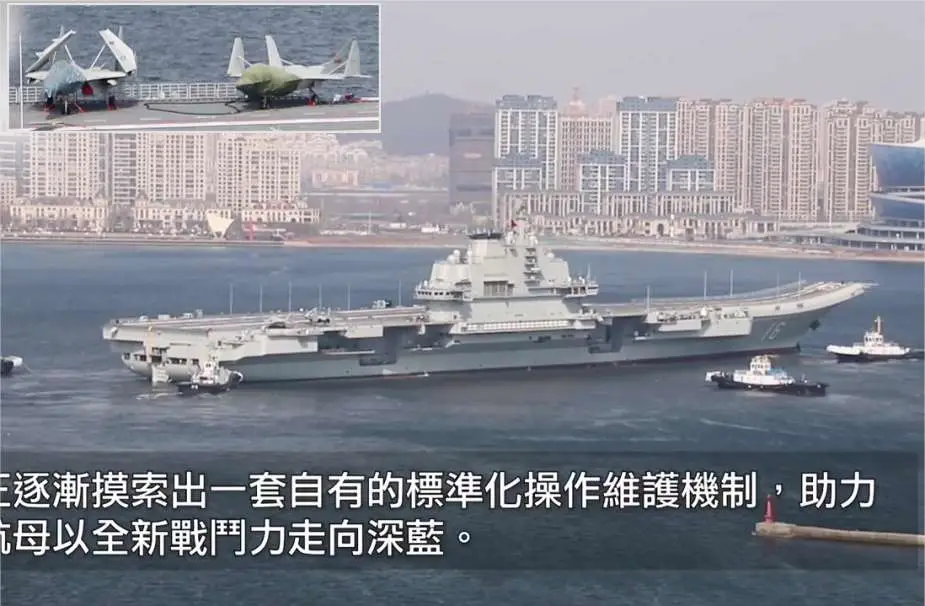Breaking news
Chinese Navy Liaoning aircraft carrier returns to sea with J-15 and J-35 jet mockups.
As reported by Caiyunxiangjiang on February 29, 2024, a new video has provided a clearer perspective on the J-35 mockup situated on the deck of the Liaoning aircraft carrier, suggesting that the vessel, after its return to sea, is undergoing deck-handling trials. This development is pivotal, as it suggests a shift from previous plans which anticipated the deployment of the J-35 on China’s forthcoming generation of carriers, specifically designed with catapult systems as opposed to the existing ski-jump ramps.
Follow Navy Recognition on Google News at this link
 The Liaoning aircraft carrier of the Chinese Navy is back at sea with mockups of J-15 and J-35 jets. (Picture source: Caiyunxiangjiang)
The Liaoning aircraft carrier of the Chinese Navy is back at sea with mockups of J-15 and J-35 jets. (Picture source: Caiyunxiangjiang)
Additionally, the imagery showcases a mockup of the J-15 fighter alongside the J-35 on the Liaoning. The J-15, a regular component of China's operational aircraft carrier groups, particularly on the Liaoning and Shandong, appears to be undergoing evaluation for compatibility and training purposes in conjunction with the J-35. The presence of the J-15 mockup, potentially hinting at a new variant of the aircraft, is indicated by the unique shape of the cockpit area, which is visible beneath its protective covering.
The J-15, known in NATO terminology as Flanker-X2 and also referred to as the Flying Shark, is China's primary carrier-based aircraft. Originating from the design framework of the Russian Su-33, it incorporates two Shenyang WS-10A engines, achieving a maximum speed of 2,410 km/h and maintaining operational range capabilities up to 3,500 km. Despite its advanced design, the J-15's operational efficacy is partially restricted by the Liaoning's ski-jump launch mechanism, impacting its fuel consumption and thereby influencing its payload capacity and maximum takeoff weight.
Andreas Rupprecht, a noted observer of Chinese aerospace developments, has discussed the potential use of the J-15 mockups for the development of an electronic warfare variant, speculated to be designated as the J-15D. This variant would represent a significant step towards enhancing the electronic warfare capabilities of the People's Liberation Army Navy (PLAN), mirroring the functionalities of comparable systems like the U.S. Navy’s EA-18G Growler.
The employment of aircraft mockups is a recognized practice in naval operations for facilitating the training of deck-handling procedures, including the operation of aircraft elevators and the management of space on the flight deck and in hangar areas. Such practices contribute to the operational readiness and efficiency of aircraft carrier crews.
Recent activities involving the Liaoning, including the integration and testing of the J-35 and potential J-15D variants, signal a progression towards more advanced maritime operations. This also indicates a continued development of the capabilities of China’s current carrier fleet, which operates primarily with Short Take-Off But Arrested Recovery (STOBAR) systems, in contrast to the future catapult-assisted takeoff but arrested recovery (CATOBAR) systems planned for new carriers.
The J-35, specifically designed for carrier operations, while limited by the ski-jump ramp system, is expected to offer new operational capabilities. Designed for single-pilot operations, the aircraft is tailored for carrier compatibility and aerodynamic efficiency, featuring specifications that support its role in varied mission scenarios. The aircraft's design facilitates a balance between maneuverability and operational range, complemented by an array of advanced onboard avionic systems.
The unfolding scenario surrounding the J-35 and the upgraded J-15 variants on Chinese aircraft carriers reflects the country's ongoing efforts to expand and refine its naval air power capabilities. These advancements are indicative of China's broader military modernization efforts, aiming to enhance the operational scope and strategic depth of its naval forces. The Liaoning’s transition from a training to a combat platform, along with its adaptations for increased aircraft carriage and defensive capabilities, underlines the strategic evolution of China's naval ambitions and its engagement in expanding its maritime operational readiness.























